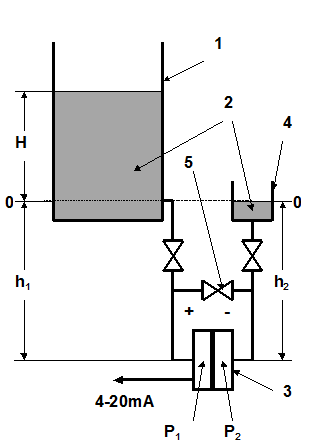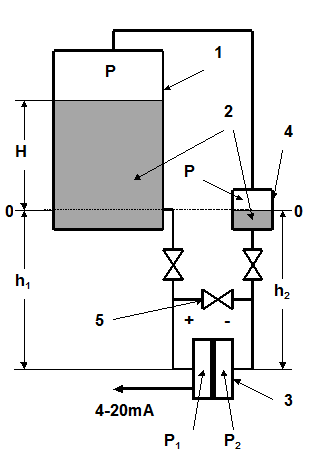The principle of this method is based on the measurement a hydrostatic pressure, caused by a liquid head, proportional to the level of liquid. There are several modifications of this method which are utilised in the following measuring systems:
• hydrostatic differential-pressure meters;
• the air-bubble tube or purging system;
• the diaphragm-box system, etc.
Among them the hydrostatic differential-pressure method is the most popular for level measurements in open (at atmospheric pressure) or in closed (under gauge or vacuumetric pressures) tanks. Figures 1 and 2 give us examples of these two cases. A tank 1 at atmospheric or gauge (or vacuumetric) pressure is filled with liquid 2 which level is to be measured.
A ‘positive’ chamber of the differential pressure transmitter 3 is connected to the tank 1 by tubing, whereas its ‘negative’ chamber is connected to a surge tank 4 which internal diameter is greater than that of tubing. Terms ‘positive’ and ‘negative’ indicate that pressure in the second chamber is lower compared with that in the first one. This doesn’t mean that the pressure is negative.
A valve 5 is used to equate pressures in these two chambers of the differential pressure gauge, in order to check its zero point. This valve must be closed during level measurements. The liquid, which fills the surge tank, should be the same as that under measurement. Left and right tubes should be close to each other, because variations of an ambient temperature will cause the same changes in liquid density in both tubes.
Since the diameter of the surge tank is greater than the diameter of tubing, therefore, the liquid displaced by the membrane in the differential pressure transmitter into the surge tank will not change the level in it. To eliminate the influence of variations of process pressure P in the big tank on the results of level measurement, the upper part of the big tank is connected with the upper part of the surge tank by tubing.
Figure 1. Level measurement in an open tank.

Figure 2. Level measurement in a closed tank

The differential pressure measured by the differential pressure transmitter is equal to the level.